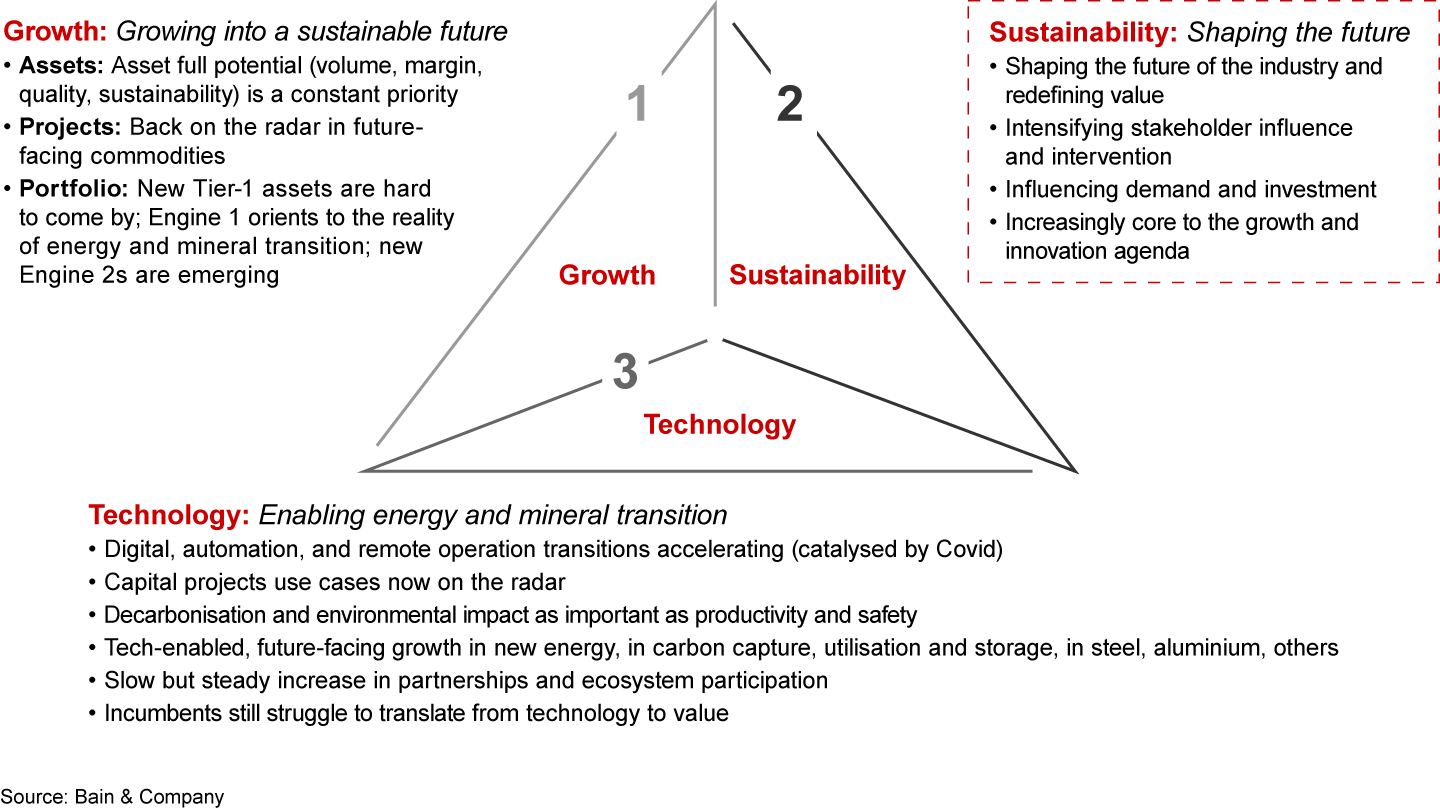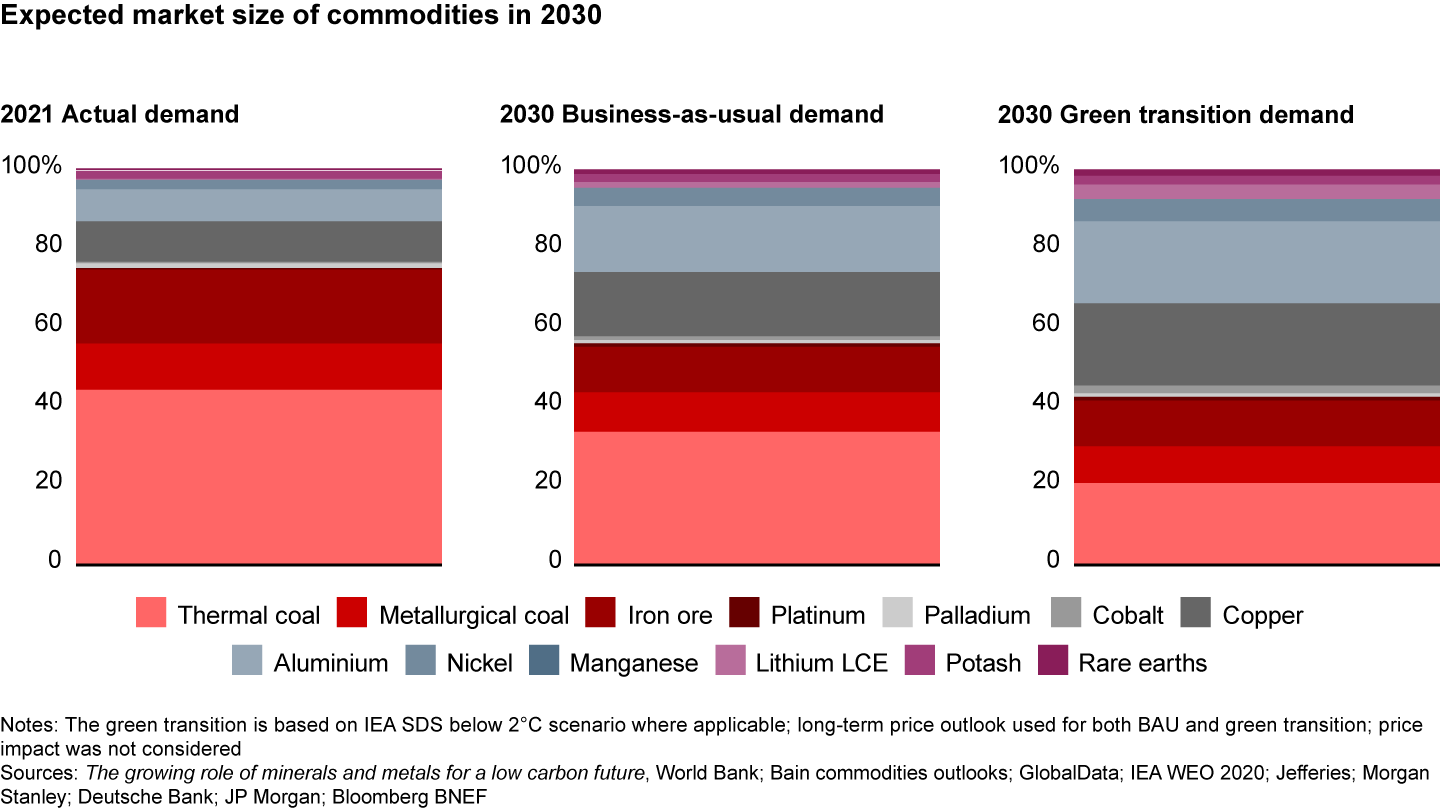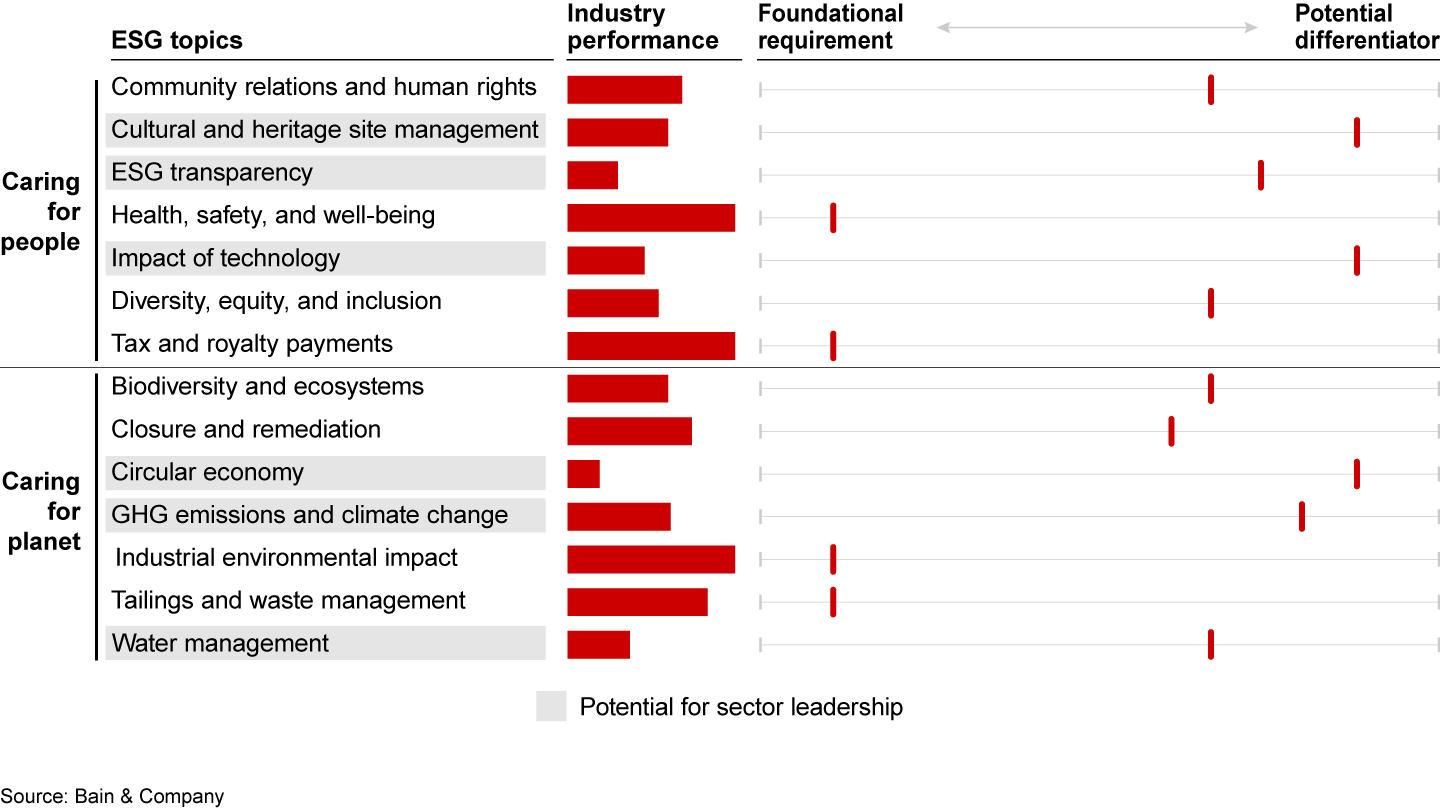Brief

Auf einen Blick
- Pressure is building on mining companies to deliver compelling and measurable results on environmental, social, and governance (ESG) imperatives.
- At the same time, resource transition and broader ESG dynamics are presenting tremendous opportunities to link ESG outcomes and value creation.
- As ESG-focused targets become the norm, leaders will differentiate through how they deliver positive results at scale and pace.
The future of the mining industry is increasingly being shaped by environmental, social, and governance (ESG) imperatives. The expectation of a transition to net zero by 2050 (or sooner) is well established, but external stakeholders are gaining more influence on how ambitiously mining companies address a host of ESG-related priorities.
Activists are launching sophisticated and effective campaigns with social media and public support. In 2021 alone, successful action was taken by Glass Lewis, Proxinvest, Market Forces, and others. Combined with support from traditional institutional investors, such actions are leading to broad investor backing for bold sustainability targets and progress.
Concurrently, governments are more actively protecting local safety, environments, and heritage sites through legislation. Customers are voting with their wallets for suppliers and products that support ESG principles. And a new generation of labour is expressing a clear desire to work for companies that are responsive to ESG issues. Galvanised by the same forces, the clean energy transition is now leading a resource transition and increasing demand for commodities that directly support electrification and the decarbonisation of energy.
ESG agendas are not the only force dictating the industry’s future. New technologies are enabling energy and mineral transition, and “future back” issues have more sway in growth ambitions. Both are working in concert with new and emerging sustainability expectations to open a once-in-a-generation window to create distinctive value while transitioning to a zero-carbon future (see Figure 1).

However, enacting an ESG agenda alone will not unlock new sources of value or even provide a cushion against disruption. Industry players will need to take a three-pronged approach to develop and fully realise new value-generating capabilities:
- look around the bend to prepare for tomorrow’s challenges (without losing sight of today’s issues);
- focus on opportunities for value creation; and
- enable successful delivery of opportunities and commitments.
To that end, the “how” will be as important as the “what” over the near term.
Look around the bend
The mining industry has long focused on goals and targets that are encompassed by the ESG umbrella. Safety, air and water quality, human rights, and a responsible approach to taxes and royalties are essential to maintaining licence to operate. In the past five years, greenhouse gas emissions (including Scope 3) and the push towards net zero, tailings, and First Nation rights have also emerged as key themes.
Yet even as they tackle the issues visible in today’s headlights, mining executives need to be ready for what lies around the bend.
Fortunately, there is no need to speculate about what they might be. The issues that will dominate the conversation over the next three to five years are already being articulated by key stakeholders. Bain & Company research and analysis reveals three emerging trends:
- Communities, in return for access to mineral resources, are demanding more involvement, engagement, and value sharing to protect their environmental, social, and economic interests. They do not want to be informed about mining company activities; they want to be part of the solution. Stakeholders are also raising questions about how technology and automation affects local employment rates and job creation.
As communities gain more influence over decision making and operations, they are finding they can flex their muscle and block licence to operate if their concerns are not adequately addressed. To protect their investments, mining companies will need to rethink how they protect and share value with the communities that are home to their mine sites. In addition, they need to start strategizing post-mining plans for closure and remediation to assure environmentally and socially positive results.
- The circular economy is poised to disrupt the mining industry—and not just because of regulatory pressure. Resource scarcity and customer preferences for sustainable products will require industry players to consider their role in the recovery and recycling of scrap materials as a key pathway to low-carbon production.
This shift is likely to accelerate as more countries pass legislation to support or require circularity. For example, the European Union’s proposed Circular Economy Action Plan could lead to tighter regulation for the production and recycling of batteries, including those from battery electric vehicles (EVs). The legislation calls for increasing the collection rate of portable batteries from 45% to 65% in 2025 and to 70% by 2030 to keep valuable materials—including cobalt, lithium, nickel, and lead—in the economy. In the US, the Bipartisan Infrastructure Law will direct more than $7 billion towards producing and recycling critical minerals without new extraction or mining as part of an effort to bolster the US battery supply chain.
- ESG transparency expectations from various stakeholders are increasing amid mining’s critical role in the global carbon transition. It’s not enough for companies to set and communicate goals; customers, investors, and regulators want to see evidence of performance. Even industry certifications, once the gold standard of proof of performance, are transitioning to a minimum requirement for transparency. Upstream and downstream visibility, supported by digital tools, will be critical for next-generation mining supply chains, providing differentiated product offerings and “supplier of choice” opportunities.
Backed by transparency-enabling technologies, some leading mining companies are pursuing green copper, responsible steel, and low-carbon aluminium as potentially differentiated commodities. One mining company is using blockchain to enable traceability, which has led to partnerships for ethically sourced EV battery raw materials. Another global mining firm is using blockchain to provide sustainability labelling for aluminium. The initiative has created a supply partnership opportunity with a leading beverage machine manufacturer to supply responsibly sourced aluminium coffee capsules.
Focus on opportunities for value creation
Fundamentals that add value—including portfolio mix, resource quality (volume, grade, cost), project delivery, price, and access to capital, talent, and technology—have not changed. What has changed is the role that ESG initiatives can play in creating opportunities alongside those value drivers. Within the next five years, ESG-rooted strategies will be key to unlocking opportunities in four critical areas.
Developing a future-focused portfolio
The biggest value-creation opportunity for mining companies lies in portfolios that are tilted towards commodities essential to the clean energy transition. Although the transition will be significantly more minerals intensive, the speed of transition has the potential to dynamically shift profit pools (see Figure 2). The growth of niche commodities (such as rare earths, cobalt, platinum, and iridium) at the expense of bulk commodities (including coal and iron ore) will likely test the strategy of “core commodity pillars” for many industry players.

Given these major transitions in the demand for and use (and reuse) of minerals, the portfolio of the future will by necessity be more diverse and complex. It will essentially redefine the meaning of Tier 1 assets. Focusing on or diversifying into core carbon transition minerals now will ensure that industry players are well positioned for future shifts.
Participating in the circular economy
Likewise, the rise of the circular economy and growth in metals recycling will influence the demand for virgin ore. We are already seeing this in steel and aluminium production, and the seeds have been sown in the platinum, copper, and battery metals market.
Industry players have an opportunity not only to rebalance their commodity portfolios in favour of future mineral demands but also to reconsider their business models. Instead of being just a minerals company, industry players can become a “circular minerals and mining company.” Transitioning from “take, make, and waste” to “take, make, recover, and reuse” will enhance core revenue and maximise the value of end-of-life materials. Recycled materials will shift down the cost curve, reducing supply costs and hedging against volatility in raw material pricing. Likewise, companies can use their circularity processes to attract sustainability-focused customers. Our research shows that some companies with steady core businesses are already investing in adjacent circular economy growth engines with strong ESG benefits.
There is a compelling business case for circularity, but making the transition requires time to successfully structure and scale circularity initiatives. To capture emerging circular profit pools, mining companies need to begin exploring and developing initiatives now. Promising opportunities include investing in secondary metals recycling and processing, urban mining, and enhanced recovery from mining waste streams. Other options include partnering with adjacent industries, such as battery recycling companies, to recover and reuse critical minerals.
Ensuring access to capital
The bar for access to capital is rising as a growing number of investors and financial institutions are aligning investment decisions with ESG frameworks. This trend accelerated following COP26, as 450 financial institutions holding approximately $130 trillion in assets (52% of assets under management and about 40% of banking assets) pledged to align to net-zero targets by 2050. Further, Glasgow Financial Alliance for Net Zero and International Financial Reporting Standards Foundation’s new International Sustainability Standards Board makes it easier for investors to assess companies based on common financial and sustainability performance standards.
As a result, mining companies with unabated carbon-intensive operations or exposure to nongrowth minerals will face increased scrutiny from both equity and debt financers and greater risk to capital access. However, companies with exposure to growth minerals and the ability to score high on ESG assessments will have an easier time clearing hurdles to capital and gaining access to green financing instruments. The ability to thrive over the next few decades will require mining companies to show they can profitably execute a robust, multifaceted ESG agenda.
The ability to recruit and retain skilled labour underpins value creation regardless of a company’s commitment to ESG initiatives. However, heightened awareness about sustainability, combined with generational shifts, have given rise to a workforce that desires purpose-filled careers. This rising generation wants to work for companies that share their values.
Companies that want to stand out need to embrace an end-to-end approach to making ESG a core component of their organisations. Industry players will need to go beyond touting workplace safety and invest in mental well-being; reskilling for the future of work; and diversity, equity, and inclusion (DE&I) initiatives. ESG will need to be embedded in everything they do, across business functions and within organisational priorities, to touch everyone from leadership to operators, suppliers, and customers. This visible commitment to a culture of innovation and “people and planet first” will create a clear winning proposition that attracts and retains talent.
Enable successful delivery
The capture of value-creation opportunities will hinge on how effective companies are at developing and implementing ESG initiatives—and therein lies the challenge. Executing against well-intended ESG targets is empirically difficult compared to standard change programmes. Mining companies are already up against numerous obstacles as they work to deliver on today’s ESG targets, such as carbon reduction. The challenges will only grow over the near term, especially as the demand for tangible results intensifies.
But the factors behind change are converging in such a way that the status quo will not be a viable strategy over the long term. For industry players, distinctively good execution (the “how”) must become a strategic priority. Based on our work in the industry, we see four actions that executives need to implement to make the most of the moment:
Make clear choices on where to be distinctive. There is much work to be done across the ESG spectrum, but mining companies cannot be all things to everyone. Companies should champion two or three ESG issues that fall outside of highly regulated domains. It’s not enough to meet the bare minimum; companies will need to set a truly differentiated aspiration for bold changes that address the industry’s main challenges. There is room to claim a position of leadership (see Figure 3). As companies implement more tools to track and report on their progress, they’ll uncover additional opportunities to reduce risk and capture growth.

Establish effective targets. To meet the demands of the moment and tap into new sources of value, industry players need to make a deliberate shift from aspirational targets to executable goals. They can set a compelling yet attainable vision for their future state through effective targets that:
- are holistic and inclusive of all elements (for example, prioritising DE&I initiatives that push beyond achieving gender balance);
- institute time frames that are at short enough intervals to demonstrate results (such as setting a target of 2030 vs. 2050, or even setting annual targets to 2030); and
- include accountability measures that are linked to key performance indicators and published regularly to ensure full transparency.
Engage a broader stakeholder group. Enacting a sustainability agenda is a cross-functional undertaking with multiyear timelines. Too often, the momentum to act gets snagged in the crosscurrents of competing operational agendas. Progress requires a fundamental shift in mindset regarding how success is defined. In addition, companies will need to acknowledge they cannot undertake all these initiatives on their own. New business models and partnerships may be required to enact some or all their agendas. Greater transparency will enable the level of engagement, efficiency, and risk reduction needed to build, acquire, or partner on next-generation capabilities.
Empower the front line to take ownership. To achieve lasting change, mining companies need to weave sustainability aspirations into their culture and empower “line-led and line-owned” accountability. When those with boots on the ground understand the why as well as the how behind the strategy, they will be more invested in operational success. With the right factors in place, mine sites can become clean, zero-carbon, employment-generating centres that are a source of value not just for local communities, but society as a whole. Accomplishing this will require local insight into solution design.
ESG imperatives are rapidly shifting from feel-good policies and must-have mandates to core differentiators for competitiveness. Delivery will be key to a winning strategy—but the window of opportunity is closing fast. The ability to unlock new value, sustain growth, and influence outcomes will require a disciplined response. Anticipating what’s around the bend, focusing on opportunities for value creation, and investing in distinctively good execution will determine the winners as the industry adapts to society’s changing needs and stakeholder demands.


